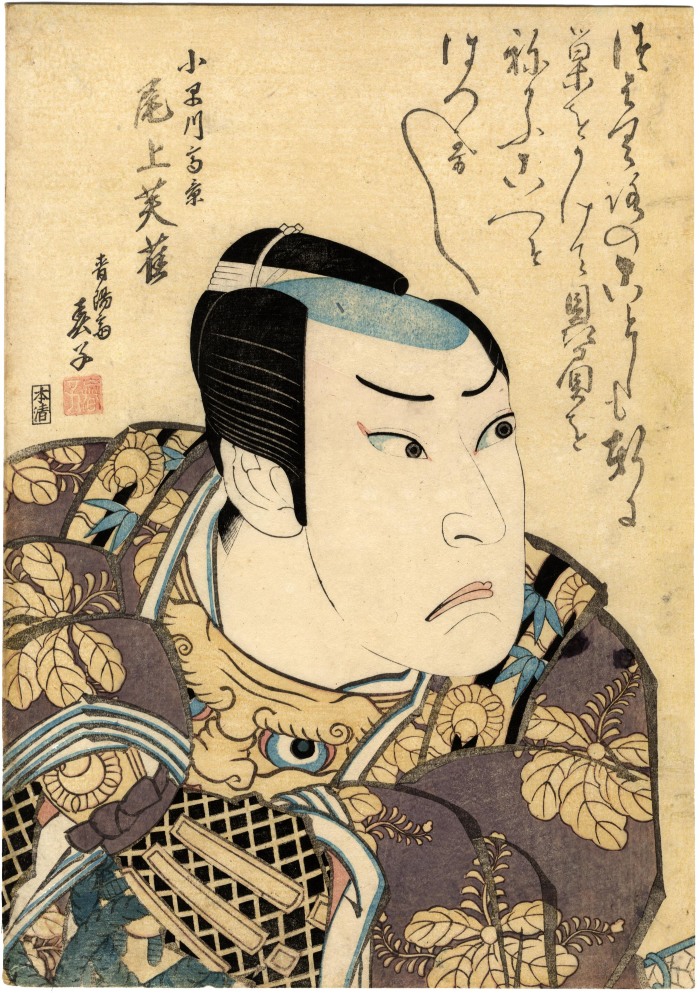Seiyōsai Shunshi (青陽齋春子) (artist )
Onoe Fujaku III (尾上芙雀) as Kobayakawa Takakage (小早川隆景)
ca 1826
10.4 in x 14.75 in (Overall dimensions) Japanese woodblock print
Signed: Shun'yosai Shunshi (春陽斎春子)
Publisher: Honya Seishichi (本清)
(Marks 123 - seal 25-527)
Metropolitan Museum of Art - the gift of Mikki and Sebastian Izzard John T. Carpenter, the Mary Griggs Burke Curator of Japanese Art at the Metropolitan Museum of Art, said in a video lecture, from November 4, 2022, 'A Poetics of Inscribed Kabuki Actor Portraits', said of this print by Shunshi: "...one of my favorite Osaka prints ever made..." Carpenter continued: "We are sure he studied under Hokushu, and all of his known works are actor portraits. But we suspect that he was not a professional artist, but rather a fan of kabuki who created these works as an avocation."
****
The curatorial files at the Met say: "This dramatic bust portrait of Onoe Fujaku III (1793–1831) captures the Osaka-based actor as a samurai garbed in a brilliant purple surcoat with paulownia crests, covering armor that has a breastplate in the form of a demon mask with piercing eyes. Fujaku is shown in a role based on the real-life daimyo Kobayakawa Takakage (1533–1597), who became an ally of the great warlord Toyotomi Hideyoshi. Theater fans enjoyed the clever and playful ways in which Kabuki playwrights rewrote history."
"Though the role is named on the print, we have yet to find records of play represented."
"Though unsigned, the poem—a 31 syllable kyōka (witty poem)—is assuredly by the actor himself. The actor likens himself to a swallow returning home to build a nest in the early summer; according to Japanese folklore, swallows are said to sing greetings (tsubame no aisatsu) when they migrate from and back to the north. Perhaps the actor is suggesting that for this season he is returning to one of his former homes at one of the small theaters (hama shibai) in Osaka where he established himself as an actor, rather than the larger Ōnishi no Shibai, where he was regularly performing in his final years—that is, until it was destroyed by fire in the second month of 1827. Or he might possibly be referring to a return trip from Nagoya, where he performed intermittently in the early 1820s (including during the third to sixth months of 1824). Future research might connect the print to a particular performance and more precise date. Fujaku’s posthumous Buddhist name (kaimyō) was Myōon’in 妙音院, which literally means “exquisite sound,” so we can assume he had a soft but elegant voice. The kyōka reads:"
つはくろの ことしも軒に 巣をかけて
贔屓をねかふ こへそはつかし
"Tsubakuro no
kotoshi mo noki ni
su o kakete
hiiki o negau
koe zo hazukashi
Like a barn swallow,
again this year, building
its nests in the eaves,
we humbly lift our voices
to gather new admirers.
(Trans. John T. Carpenter)"
****
Kobayakawa Takakage (小早川隆景) lived from 1533 to 7/26/1597.
Kyōto-Osaka prints (kamigata-e - 上方絵) (genre)
actor prints (yakusha-e - 役者絵) (genre)
Onoe Fujaku III (三代目尾上芙雀: from 1818 or 1819 to 1/1831) (actor)
